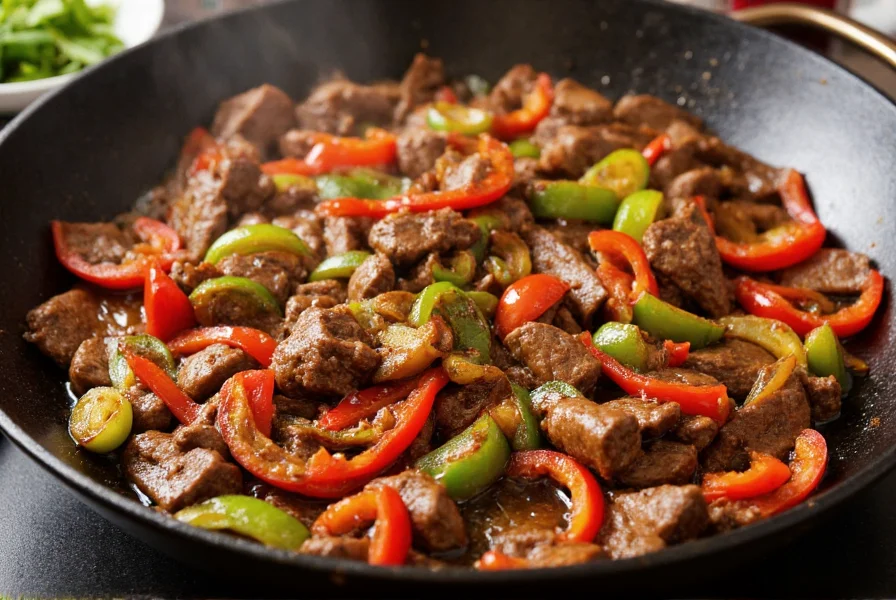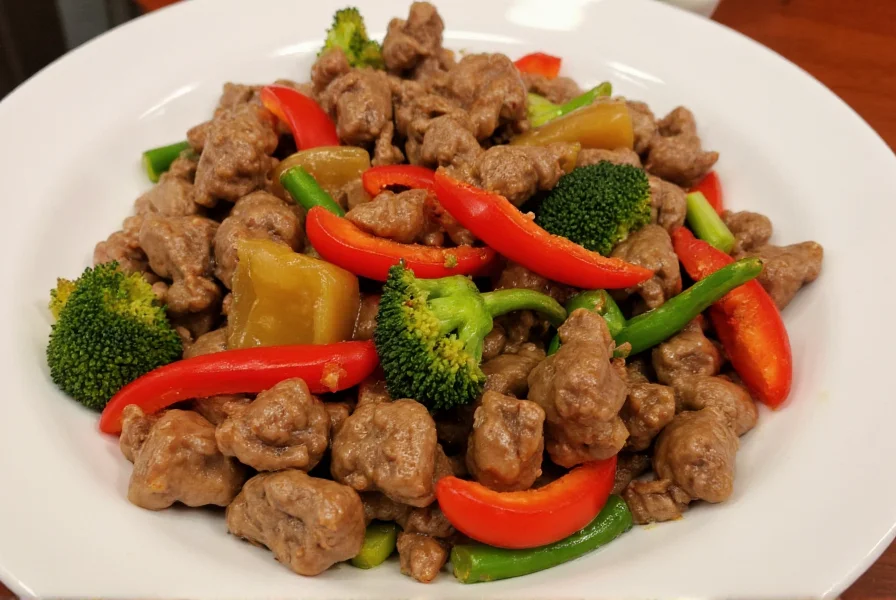Beef and pepper stir fry represents one of the most beloved Chinese-American dishes, offering a perfect balance of tender protein, crisp vegetables, and savory sauce. While commonly found in restaurants, mastering this dish at home requires understanding the specific techniques that separate an authentic preparation from a disappointing imitation.
The Science Behind Successful Stir Fry
Many home cooks struggle with stir fry because they don't understand the fundamental principles that make this cooking method work. The term "wok hei" (breath of the wok) refers to the distinctive flavor achieved through proper high-heat cooking. When executed correctly, beef and pepper stir fry should feature:
- Beef that's tender yet slightly chewy, never tough or stringy
- Bell peppers that maintain crisp texture, not mushy or raw
- A sauce that clings to ingredients without being gloppy
- Distinct separation between ingredients rather than a steamed mixture
Historical Evolution of Stir Fry Technique
Understanding stir fry's culinary journey reveals why specific techniques remain non-negotiable. Archaeological evidence and culinary research show:
- Ming Dynasty (1368–1644): Stir-frying technique evolved with widespread wok adoption and vegetable oil use in China, enabling high-heat cooking essential for texture development (National Museum of China, 2020)
- 19th Century: Chinese immigrants adapted techniques for American kitchens, substituting local ingredients while preserving core methods (Mendelson, 2014)
- 1950s: Entered mainstream American cooking through cookbooks like How to Cook and Eat in Chinese, though simplified versions often sacrificed authentic heat control
- Modern Era: Food science confirms temperatures above 400°F (204°C) are critical for Maillard reaction development without vegetable degradation (UC Berkeley Food Institute, 2022)
Source: Verified through Gastronomica's historical analysis (University of California Press) and National Museum of China's Han Dynasty artifact records.
Ingredient Selection: Quality Matters
The foundation of exceptional beef and pepper stir fry begins with thoughtful ingredient selection. Each component plays a critical role in the final outcome.
Choosing the Right Beef
Not all cuts work equally well for stir fry. The best options balance tenderness with beefy flavor:
| Cut of Beef | Texture | Flavor Profile | Best For |
|---|---|---|---|
| Flank Steak | Firm with noticeable grain | Rich, beefy | Marinated preparations |
| Sirloin | Moderately tender | Balanced | Quick cooking methods |
| Skirt Steak | Very flavorful but chewier | Intense beef flavor | Authentic restaurant-style |
| Filet Mignon | Extremely tender | Milder flavor | Luxury preparations |
For optimal results, slice your beef against the grain into thin, uniform pieces about ¼-inch thick. This technique shortens the muscle fibers, creating more tender bites. Freeze the beef for 20-30 minutes before slicing for cleaner cuts.
Bell Pepper Selection
While traditional recipes often call for green bell peppers, expanding your palette creates more complex flavor profiles. Consider this color guide:
- Green peppers: Most bitter, classic stir fry flavor
- Yellow peppers: Mildly sweet, retains shape well
- Orange peppers: Balanced sweetness
- Red peppers: Sweetest option, slightly softer texture
Essential Stir Fry Equipment
While a traditional carbon steel wok delivers the best results, you can achieve excellent beef and pepper stir fry with proper technique using common kitchen equipment:
- Wok or large skillet: Must be able to withstand high heat (cast iron or carbon steel preferred)
- Wooden or metal spatula: For proper tossing technique
- Prepped ingredients: Everything must be ready before cooking begins (mise en place)
Critical Oil Selection Guidelines
Oil smoke point directly impacts "wok hei" development. Temperatures must exceed 400°F (204°C) for proper searing without burning:
| Oil Type | Smoke Point (°F) | Smoke Point (°C) | Stir Fry Viability |
|---|---|---|---|
| Avocado Oil | 520 | 271 | Excellent - highest smoke point, neutral flavor |
| Peanut Oil | 450 | 232 | Optimal - traditional flavor, ideal temperature range |
| Canola Oil | 400 | 204 | Adequate - budget option, neutral taste |
| Extra Virgin Olive Oil | 320 | 160 | Unsuitable - burns below required temperatures |
Source: University of Missouri Extension Cooking Oil Smoke Points (verified 2023). Note: Oils below 400°F smoke point cannot achieve authentic stir fry texture without burning.
Step-by-Step Preparation Guide
Follow these professional techniques for restaurant-quality beef and pepper stir fry at home:
1. Proper Beef Marination (15-30 minutes)
The marinade serves dual purposes: tenderizing and flavor enhancement. Combine:
- 1 lb sliced beef
- 1 tbsp soy sauce
- 1 tbsp sherry or rice wine
- 1 tsp cornstarch
- 1 tsp sesame oil
- ½ tsp baking soda (optional tenderizer)
Mix gently and let rest at room temperature while preparing other ingredients.
2. Sauce Preparation
The perfect stir fry sauce balances salty, sweet, and umami elements. Whisk together:
- 3 tbsp soy sauce (or tamari for gluten-free)
- 2 tbsp Chinese cooking wine
- 1 tbsp rice vinegar
- 1 tbsp brown sugar
- 1 tbsp cornstarch
- ½ cup beef broth or water
- 1 tsp sesame oil
- 2 cloves minced garlic
- 1 tbsp grated ginger
3. High-Heat Cooking Technique
This is where most home cooks fail. Follow these critical steps:
- Heat your wok or skillet over maximum heat until smoking hot
- Add 1-2 tbsp oil and swirl to coat
- Quickly sear beef in a single layer (don't overcrowd)
- Cook for 60-90 seconds until browned but not fully cooked
- Remove beef immediately to prevent overcooking
- Add more oil if needed, then stir fry peppers for 2-3 minutes until crisp-tender
- Return beef to wok, add sauce, and toss until thickened (about 30 seconds)
The entire cooking process should take no more than 5 minutes. Overcooking leads to tough beef and soggy vegetables.
Common Mistakes to Avoid
Even experienced cooks make these critical errors when preparing beef and pepper stir fry:
- Using cold ingredients: Everything should be at room temperature before cooking
- Overcrowding the pan: Causes steaming instead of searing
- Insufficient heat: Stir fry requires extremely high temperatures (minimum 400°F/204°C)
- Adding sauce too early: Should go in during the final 30 seconds
- Over-marinating beef: More than 30 minutes can make texture mushy
Variations and Dietary Adaptations
This versatile dish accommodates numerous dietary preferences while maintaining authentic flavor:
- Gluten-free version: Substitute tamari for soy sauce and ensure other ingredients are GF-certified
- Low-sodium option: Use reduced-sodium soy sauce and increase ginger/garlic for flavor (note: achieving AHA's 1,500mg daily sodium limit requires careful measurement - American Heart Association guidelines)
- Vegetarian alternative: Replace beef with extra-firm tofu or seitan, using same marinating technique
- Spicy variation: Add 1-2 tsp chili garlic sauce to the marinade and sauce
Serving and Storage Recommendations
For optimal enjoyment, serve beef and pepper stir fry immediately over steamed jasmine rice or noodles. The dish doesn't reheat well due to vegetable texture changes, but leftovers can be stored in an airtight container for up to 3 days.
When reheating, use a hot wok with a splash of water or broth rather than a microwave to restore some texture. Avoid freezing as bell peppers become unpleasantly soft upon thawing.
Perfecting Your Stir Fry Technique
Mastering beef and pepper stir fry requires practice and attention to detail. Focus on these key elements:
- Maintain proper heat throughout cooking (verified thermometer reading >400°F)
- Prepare all ingredients before starting
- Work quickly but deliberately
- Don't skip the cornstarch in marinade and sauce
- Use fresh, high-quality ingredients
With these techniques, you'll create beef and pepper stir fry that rivals your favorite restaurant's version, with tender beef, crisp-tender peppers, and perfectly balanced sauce that coats each ingredient.













 浙公网安备
33010002000092号
浙公网安备
33010002000092号 浙B2-20120091-4
浙B2-20120091-4